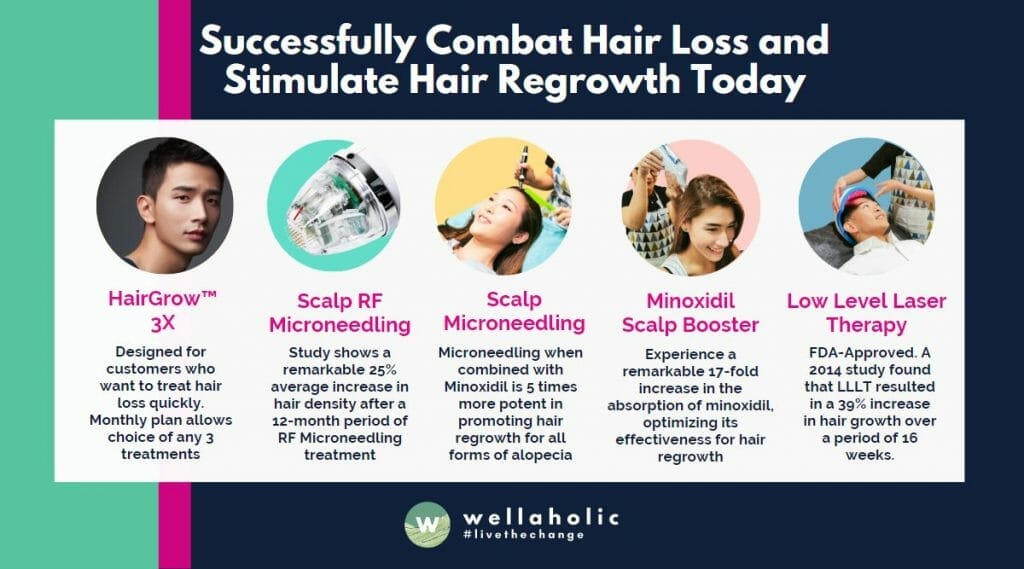
From Thinning to Winning: Conquering Alopecia and Restoring Your Confidence

From Thinning to Winning: Conquering Alopecia
Take control of your hair loss journey and restore your confidence with proven solutions.
50% of men experience noticeable hair loss by age 50
95% success rate with combined treatment approaches
3-6 months to see visible improvement with consistent treatment
80% of patients report improved self-confidence after treatment
Effective Treatment Options 🧪
Low Level Laser Therapy – Stimulates follicle growth
Topical Treatments – Minoxidil and DHT blockers
Nutritional Support – Essential vitamins and minerals
Scalp Treatments – Improves circulation and health
Take the first step toward hair restoration and renewed confidence!
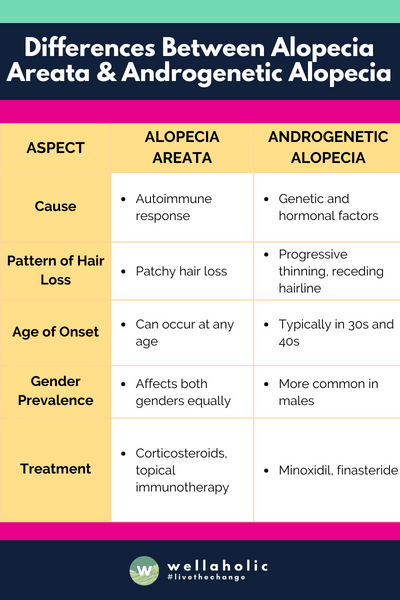
Introduction to Alopecia Areata and Androgenetic Alopecia
Have you ever noticed more hair than usual on your brush or in the shower drain?
Hair loss can be a distressing experience, affecting both men and women of all ages. Two common types of hair loss that we often see in our customers at Wellaholic are alopecia areata and androgenetic alopecia. While they may sound similar, these conditions have distinct causes and characteristics. Alopecia areata is an autoimmune disorder that leads to patchy hair loss, while androgenetic alopecia, also known as male or female pattern baldness, is influenced by genetics and hormones.
In this article, we’ll explore the key differences between these two types of hair loss, their symptoms, and the treatment options available to help you understand and address your hair concerns.
Table: Characteristics of of Alopecia Areata and Androgenetic Alopecia
To start off, here’s a simple a table showing the characteristics of Alopecia Areata and Androgenetic Alopecia:
| Characteristics | Alopecia Areata | Androgenetic Alopecia |
|---|---|---|
| Cause | Autoimmune disease | Genetic inheritance |
| Age of Onset | Any age | Usually after puberty |
| Pattern of Hair Loss | Patchy hair loss | Gradual hair thinning |
| Hair Loss Location | Scalp, face, and body | Crown and temples |
| Rate of Hair Loss | Sudden onset | Slow and progressive |
| Regrowth Potential | Spontaneous regrowth | Unlikely to regrow |
| Treatment Options | Corticosteroids, Minoxidil | Finasteride, Minoxidil |
| Side Effects of Treatment | May include skin thinning, bruising, or change in pigmentation | May include sexual dysfunction or decreased libido |
Hair loss is a prevalent problem among Asians. According to a survey conducted by Wellaholic in Singapore in 2022, around 44% of respondents cited hair loss as their top beauty concern.

What is Alopecia Areata?
Alopecia areata is a common autoimmune disorder that causes hair loss in patches on the scalp, face, and other parts of the body. At Wellaholic, we often see customers experiencing this condition, which can be quite distressing. The hair loss typically occurs in small, round patches about the size of a quarter, but it can be more extensive in some cases.
We’ve noticed that alopecia areata can affect people of all ages and genders, though it often starts in childhood or early adulthood. The condition is unpredictable, with hair sometimes growing back on its own, only to fall out again later. While alopecia areata doesn’t cause any physical pain or illness, we understand it can have a significant emotional impact on those affected. It’s important to know that this condition is not contagious and doesn’t indicate any serious underlying health issues.

What are the Symptoms of Alopecia Areata?
Alopecia areata typically manifests as sudden hair loss in round or oval patches, often about the size of a quarter. These patches usually appear on the scalp, but can occur anywhere on the body, including the beard, eyebrows, and eyelashes. The affected areas are smooth and show no signs of redness, rash, or scarring. In some cases, people may experience a tingling, itching, or burning sensation in the area just before hair loss occurs.
While hair loss is the primary symptom, alopecia areata can also affect the nails. Some people may notice changes such as tiny dents (pitting), roughness, or brittleness in their fingernails and toenails. The extent of hair loss can vary greatly from person to person. Some individuals may only experience a few small patches of hair loss, while others may lose hair over larger areas of the scalp or body. In rare cases, the condition can progress to complete hair loss on the scalp (alopecia totalis) or the entire body (alopecia universalis). It’s important to note that the course of alopecia areata is unpredictable, with periods of hair regrowth and loss often occurring cyclically.
Alopecia areata, an autoimmune disorder that causes hair loss, is more common among Asians than in other ethnic groups. The incidence of alopecia areata in Asians is estimated to be around 0.2-0.3%, based on research by Wellaholic.

What are the reasons for Alopecia Areata?
At Wellaholic, we often see customers who are concerned about sudden hair loss in patches. This condition is known as alopecia areata, and it’s an autoimmune disorder. In simple terms, the body’s immune system mistakenly attacks hair follicles, causing hair to fall out. While the exact cause isn’t fully understood, we’ve noticed some common factors among our customers.
Genetics and Family History: Many of our customers with alopecia areata have a family member with the same condition. This suggests a genetic link.
Other Health Conditions: We’ve observed that some customers with alopecia areata also have other autoimmune diseases like thyroid problems or vitiligo.
Stress and Environmental Factors: While not a direct cause, high stress levels seem to trigger or worsen hair loss in some cases. We always remind our customers that managing stress is key for overall health, including hair health.
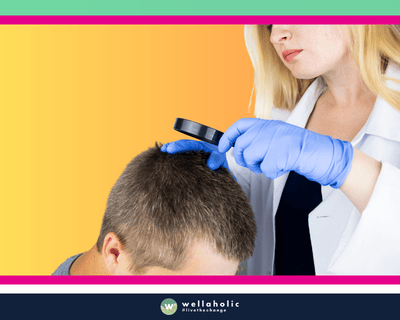
How to identify Alopecia Areata?
At Wellaholic, we often see customers who are unsure about their hair loss. Here’s how to spot alopecia areata:
Key Signs of Alopecia Areata
Patchy Hair Loss: Look for round, smooth bald spots about the size of a coin on your scalp or beard. These patches appear suddenly and have no redness or scarring.
Wider Spread: Sometimes, the hair loss can spread to larger areas. In rare cases, it may affect all the hair on the scalp or even the whole body.
Nail Changes: Check your nails for tiny dents, white spots, or rough texture. These nail changes often go hand-in-hand with alopecia areata.
No Other Symptoms: Unlike other hair loss types, alopecia areata doesn’t cause itching or pain in the affected areas. Your scalp will look normal, just without hair.
If you notice these signs, it’s best to see a doctor or hair specialist. They can confirm if it’s alopecia areata and suggest the right treatment. At Wellaholic, we’re here to help and guide you through your hair loss journey.
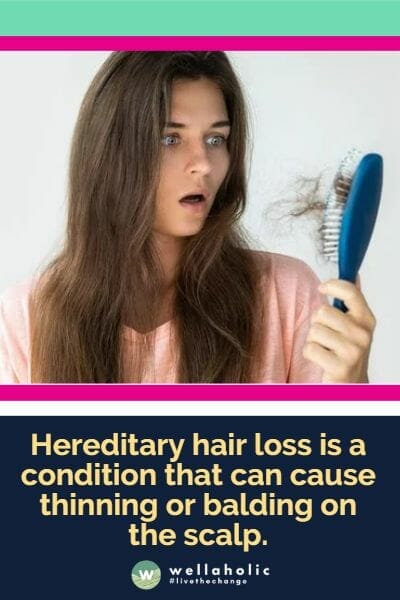
What about Alopecia in Women?
At Wellaholic, we often see women struggling with alopecia, a condition that can be quite distressing. Alopecia in women is more common than many people think. It can show up in different ways, from overall thinning to patchy hair loss.
We’ve noticed that female pattern baldness, also called androgenetic alopecia, is the most frequent type. This usually causes thinning on the top and crown of the head. Other forms of alopecia we see include telogen effluvium, which can happen after stress or hormonal changes, and alopecia areata, where hair falls out in small, round patches. Each type has its own causes and treatments. We always recommend that our customers at Wellaholic see a doctor for a proper diagnosis, as the right treatment depends on the specific type of alopecia.

How to Treat Alopecia
The type and severity of alopecia decide the treatment. Here are some common treatments I’ve seen:
Medications help a lot. Prednisone is one. It’s an oral steroid that reduces inflammation. It’s used for alopecia areata, which is when hair falls out in patches. Minoxidil is another. It’s used to stop hair loss and sometimes grows new hair. Women often use hormone modulators like Spironolactone and Flutamide. They work well with birth control pills. Men use Finasteride for pattern baldness.
Procedures also help. Hair transplantation is one way. Doctors take healthy hair from one part of the head and move it to where the hair is thinning. This can be done with FUE or FUT methods.
Lifestyle changes can also improve hair health. Eating well helps. Foods rich in iron, Vitamin A, protein, and zinc are good choices.
Other treatments include Laser Therapy, Microneedling, and PRP. These are gentle ways to encourage hair to grow back.
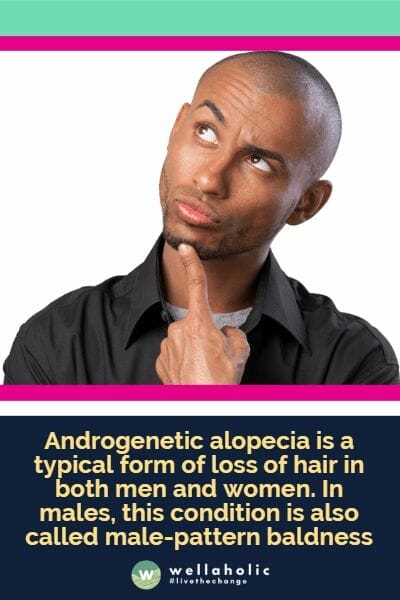
What is Androgenetic Alopecia?
Androgenetic alopecia is a common type of hair loss that affects both men and women. We often see this condition in our customers at Wellaholic. In men, it’s known as male pattern baldness. For women, we call it female pattern hair loss. This type of hair loss is linked to genetics and hormones.
For men, hair loss usually starts above the temples. The hairline moves back to form an “M” shape. The top of the head also thins out. Some men may go completely bald. Women have a different pattern. Their hair gets thinner all over the top of the head. The middle part often gets wider. Women rarely go totally bald from this condition. We’ve noticed that androgenetic alopecia can start as early as the 20s, but it becomes more common with age. By 50, about half of all men and many women show signs of this type of hair loss.

What are the causes of Androgenetic Alopecia?
At Wellaholic, we often see customers concerned about hair loss, and many ask us about the causes of androgenetic alopecia. This common form of hair loss has several factors at play.
Genetics play a big role in androgenetic alopecia. If your parents or grandparents had this type of hair loss, you’re more likely to have it too. Hormones are another key factor. In men, a hormone called dihydrotestosterone (DHT) can shrink hair follicles over time. For women, hormonal changes during menopause can lead to thinning hair. Age is also a factor, as this type of hair loss becomes more common as we get older. We’ve noticed that stress and certain medical conditions can speed up hair loss in some of our customers at Wellaholic. While we can’t change our genes, understanding these causes helps us offer better solutions to manage hair loss.

How to treat Androgenetic Alopecia?
At Wellaholic, we offer a range of treatments for androgenetic alopecia. The two main FDA-approved options are topical minoxidil and oral finasteride. Minoxidil helps stimulate hair growth in about two-thirds of men. It’s easy to use – just apply it to your scalp twice a day. Finasteride is a pill that stops the body from making DHT, the hormone that causes male pattern baldness. It’s very effective, slowing or stopping hair loss in nearly 90% of men who use it.
We also use newer treatments like low-level laser therapy (LLLT) and platelet-rich plasma (PRP) injections. LLLT uses light to boost hair growth, while PRP uses your own blood plasma to stimulate the scalp. For some customers at Wellaholic, we may suggest combining treatments for better results. This could mean using minoxidil with finasteride, or adding LLLT to your routine. The key is finding the right mix that works for you. We’re always happy to discuss options and create a plan that fits your needs and goals.

Conclusion
We’ve covered a lot of ground in this article about alopecia areata and androgenetic alopecia. These two common types of hair loss affect many of our customers at Wellaholic, and we understand how distressing they can be. While they have different causes – alopecia areata being an autoimmune condition and androgenetic alopecia linked to genetics and hormones – both can significantly impact a person’s appearance and self-esteem.
The good news is that there are effective treatments available for both conditions. From medications like minoxidil and finasteride to innovative therapies like low-level laser treatment and PRP, we have a range of options to help combat hair loss. At Wellaholic, we’re committed to finding the right solution for each individual.
If you’re experiencing hair loss, don’t hesitate to reach out. Our HairGrow 3X treatment combines Scalp RF Microneedling, Minoxidil Scalp Booster, and Low Level Laser Therapy to provide a comprehensive approach to hair regrowth. This powerful combination can help stimulate your hair follicles and improve blood circulation to your scalp, promoting new hair growth. Why not book a consultation with us today? Let’s work together to restore your hair and your confidence.
Frequently Asked Questions (FAQ)
1. What causes hair thinning or alopecia, and how can it be addressed effectively?
Hair thinning or alopecia often results from genetic predispositions, hormonal imbalances, stress, poor nutrition, or medical conditions like thyroid disorders. In Singapore’s fast-paced lifestyle, stress and dietary habits frequently exacerbate these issues. At Wellaholic, we employ scientifically-backed treatments such as Regenera Activa and Advanced Scalp Therapy to combat alopecia by stimulating natural hair growth. Our expertise ensures personalized solutions tailored to your unique needs, helping restore both hair density and confidence.
🔵 Genetic factors account for up to 80% of alopecia cases, making early intervention crucial.
🔵 Hormonal imbalances, especially in women post-pregnancy or during menopause, are common triggers.
🔵 Stress-induced shedding is prevalent in high-pressure environments like Singapore’s corporate scene.
🔵 Nutritional deficiencies, particularly iron and biotin, can accelerate hair loss if left unchecked.
🔵 Medical conditions like PCOS or thyroid issues require targeted treatment approaches.
🔵 Personalized care plans at Wellaholic address root causes while promoting healthy regrowth.
2. How does Wellaholic’s Advanced Scalp Therapy help with hair restoration?
Wellaholic’s Advanced Scalp Therapy combines cutting-edge technology with nourishing serums to create an optimal environment for hair regrowth. This non-invasive treatment uses micro-needling and nutrient infusion to stimulate dormant hair follicles, improve blood circulation, and strengthen the scalp. Backed by years of expertise, our therapists tailor each session to suit individual needs, ensuring maximum effectiveness. Customers benefit from visibly thicker, healthier hair within weeks, boosting their self-esteem significantly.
🔵 Micro-needling boosts collagen production, essential for robust hair follicle health.
🔵 Infused serums contain peptides and vitamins that repair damaged scalp tissues.
🔵 Improved blood flow delivers oxygen and nutrients directly to hair roots.
🔵 Non-surgical approach minimizes discomfort and downtime for busy professionals.
🔵 Customizable sessions cater to varying stages of alopecia severity.
🔵 Visible improvements noted after just 3-4 sessions on average.
3. Is Regenera Activa suitable for all types of hair loss?
Regenera Activa is ideal for addressing androgenetic alopecia (male/female pattern baldness) and diffuse thinning caused by aging or stress. Using autologous cell therapy, this innovative procedure extracts growth factors from your own body to rejuvenate hair follicles naturally. While not suitable for scarring alopecias or advanced baldness requiring surgical intervention, it works wonders for early-to-mid stage hair loss. With Wellaholic’s expert guidance, clients achieve sustainable results without artificial chemicals or invasive surgeries.
🔵 Autologous technique reduces risks of allergic reactions or side effects.
🔵 Growth factors extracted promote long-term follicular regeneration.
🔵 Effective for both men and women experiencing gradual thinning patterns.
🔵 Not recommended for cicatricial alopecia due to scar tissue limitations.
🔵 Best outcomes observed when combined with consistent maintenance routines.
🔵 Clinically proven method trusted worldwide for its safety and efficacy.
4. Can lifestyle changes really impact my hair health?
Absolutely! Lifestyle modifications play a pivotal role in managing hair health, especially in Singapore’s humid climate. Poor diet, lack of sleep, excessive styling, and chronic stress contribute to weakened hair strands and increased shedding. Wellaholic educates clients on adopting holistic practices such as balanced nutrition, regular exercise, stress management techniques, and proper hair care routines. By combining these habits with professional treatments, you can achieve lasting improvements in hair quality and overall well-being.
🔵 High-protein diets rich in omega-3 fatty acids support stronger hair growth.
🔵 Adequate hydration combats dryness caused by air conditioning indoors.
Regular exercise enhances blood circulation vital for scalp health.
🔵 Minimizing heat styling prevents breakage and split ends over time.
🔵 Practicing mindfulness or yoga helps reduce cortisol levels linked to shedding.
🔵 Consistent routines amplify the benefits of clinical therapies like PRP.
5. Why choose Wellaholic over other aesthetic clinics for hair restoration?
At Wellaholic, we pride ourselves on offering evidence-based solutions delivered by certified professionals who prioritize client satisfaction. Unlike generic clinics, we conduct thorough consultations to understand underlying concerns before recommending tailored treatments. Our state-of-the-art facilities utilize FDA-approved technologies like Regenera Activa and Advanced Scalp Therapy, ensuring safe and effective outcomes. With hundreds of success stories across Singapore, we’ve earned a reputation for excellence in restoring confidence through superior hair care services.
🔵 Certified therapists undergo rigorous training for precision and care.
🔵 Cutting-edge equipment guarantees industry-leading standards of safety.
🔵 Complimentary consultations provide clarity and peace of mind upfront.
🔵 Transparent pricing avoids hidden costs or unnecessary upselling tactics.
🔵 Positive testimonials reflect consistent delivery of promised results.
🔵 Convenient locations make scheduling appointments hassle-free.
6. How soon will I see results from Wellaholic’s hair restoration treatments?
Most clients begin noticing improvements in hair thickness and reduced shedding within 2-3 months of starting treatment at Wellaholic. However, significant regrowth typically occurs between 4-6 months, depending on the severity of hair loss and adherence to recommended protocols. Patience is key, as hair grows approximately 1 cm per month. Our team monitors progress closely, adjusting strategies as needed to ensure optimal recovery. The combination of advanced therapies and personalized care accelerates visible transformations effectively.
🔵 Initial stabilization of shedding happens within the first few weeks.
🔵 Noticeable densification becomes apparent around the third month mark.
🔵 Peak results manifest between 4-6 months with diligent follow-ups.
🔵 Regular monitoring ensures timely adjustments to treatment plans.
🔵 Combining therapies enhances speed and quality of regrowth outcomes.
🔵 Long-term commitment yields sustained, natural-looking results.

Serene Chiam, Aesthetic Director (LinkedIn)
Serene Chiam is the highly skilled Aesthetic Director at Wellaholic, Singapore’s premier aesthetic chain. With over a decade of expertise in the aesthetics industry, Serene brings a wealth of knowledge and experience to her role. She previously served as a Clinical Aesthetics Manager with Laser Clinics Australia, honing her skills in laser hair removal and other advanced treatments. Serene holds a CIDESCO certificate in skincare and a Bachelor of Health Science (Aesthetics) from Torrens University, Australia. Her deep understanding of the latest aesthetic technologies and techniques ensures that Wellaholic’s clients receive the most effective, long-lasting hair removal results. Serene’s passion for helping others feel confident and beautiful shines through in her dedication to providing exceptional care and achieving optimal outcomes for every client.
Contact Serene at [email protected]
GET IN TOUCH
Book Now Pay Later

HairGrow™ 3X Ultimate Hair Loss Treatment
- ⭐ Supercharged Regrowth: HairGrow™ 3X is a premium plan, crafted for individuals seeking to expedite their hair regrowth journey and tackle hair loss effectively.
- ⭐ Personalized Selection: This package lets customers pick three hair loss treatments, customizing their plan to their needs.
- ⭐ Balancing Value & Variety: HairGrow™ 3X provides a unique blend of cost-effectiveness and choice, granting access to top-tier treatments at a significant discount.
- ⭐ Free Supply of Minoxidil. HairGrow™ 3X also includes a monthly supply of Minoxidil with Royal Jelly to jumpstart hair growth.
- ⭐ Award-Winning. Wellaholic’s treatments have been recognized by top beauty publications such as Daily Vanity, Beauty Insider, and Tropika Club Magazine.
- ⭐ Over 2000 Verified Customer Reviews. Wellaholic has over 30 industry awards and over 2000 positive reviews from customers, and >50% are repeat customers.
